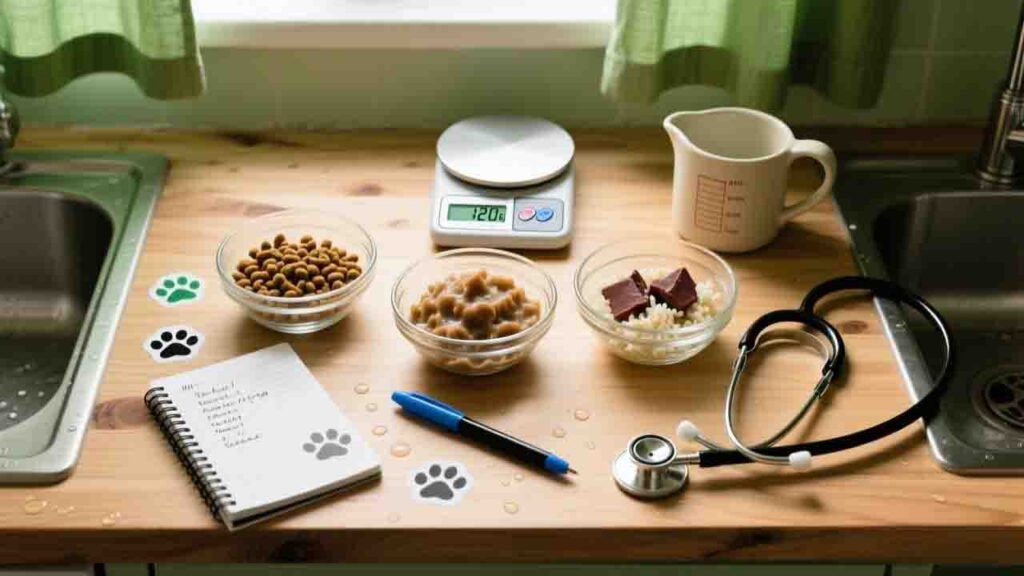That sound every pet owner recognizes—the unmistakable gagging from another room that sends you sprinting for paper towels. Or the discovery of an unexpected mess on your freshly cleaned rug. Digestive issues in our pets are more than just inconvenient; they’re important signals from your pet’s body that something is out of balance -6.
If you’ve ever wondered why your pet experiences these stomach troubles, you’re not alone. Digestive problems rank among the most common reasons pet owners seek veterinary advice. Let’s explore what’s actually happening inside your pet and how you can better understand their unique digestive language.
The Canine and Feline Digestive System: A Brief Tour
When your pet eats, food embarks on a fascinating journey through a specialized processing plant designed to extract nutrients and fuel their body.
The process begins in the mouth, where enzymes start breaking down food. It then travels to the stomach, where strong acids and enzymes further digest it while creating a hostile environment for potential pathogens. From there, the partially digested food moves to the small intestine, where nutrients are absorbed into the bloodstream with help from the pancreas and liver. The large intestine then absorbs water and hosts gut microbes (the microbiome) that ferment fiber, producing essential nutrients. Finally, waste products are eliminated -6.
This entire system relies on a delicate balance. When any part is disrupted—whether by something your pet ate, stress, or an underlying health issue—symptoms occur as your pet’s body tries to communicate that something’s wrong.
Decoding the Symptoms: What Your Pet’s Body is Telling You
Different digestive issues point to problems at specific points along the gastrointestinal tract. Understanding these distinctions can help you provide better information to your veterinarian.
Upper GI Issues (Stomach & Small Intestine):
-
Vomiting (especially soon after eating)
-
Regurgitation (passive expulsion of undigested food)
-
Yellow foam or bile (indicating an empty, irritated stomach)
-
Loss of appetite but possibly increased thirst
Lower GI Issues (Colon & Large Intestine):
-
Soft stools or diarrhea
-
Mucus in stool
-
Straining to defecate
-
Increased frequency with small amounts
-
Gas and bloating
Common Causes of Digestive Distress in Pets
Several factors can disrupt your pet’s digestive harmony. Understanding these triggers can help you prevent future episodes.
1. Dietary Indiscretion
The canine and feline version of “I shouldn’t have eaten that.” This includes scavenging, sudden changes in diet, consuming rich, fatty, or unfamiliar foods, or getting into the trash. Their systems aren’t designed to handle these surprises, leading to rapid rejection or improper digestion.
2. Gut Microbiome Imbalance
Your pet’s digestive tract hosts a complex ecosystem of bacteria, fungi, and other microorganisms collectively called the gut microbiome. When harmful bacteria outnumber beneficial ones—due to stress, antibiotics, or poor diet—it can lead to chronic soft stools, gas, bloating, and poor nutrient absorption.
3. Food Sensitivities
Unlike true allergies that often cause itching, food sensitivities primarily trigger digestive responses. These can develop suddenly, even to foods your pet has eaten for years. Common triggers include specific protein sources, though grains are less frequently the culprit than many pet owners assume.
4. Underlying Health Conditions
Sometimes, digestive symptoms signal deeper medical issues requiring veterinary attention. These can include pancreatic insufficiency, inflammatory bowel disease, thyroid disorders, or intestinal parasites.
Creating a Digestive Care Plan: Practical Strategies
While serious symptoms always warrant veterinary attention, many mild digestive issues can be managed with thoughtful home care.
Step 1: The Elimination Approach
If you suspect a food sensitivity, work with your veterinarian to implement an elimination diet. This involves feeding a single novel protein and carbohydrate source for 8-12 weeks, then carefully monitoring symptoms. This method remains the gold standard for identifying food triggers.
Step 2: Support the Gut Environment
-
Prebiotics: These non-digestible fibers act as food for beneficial gut bacteria, helping them thrive and multiply.
-
Probiotics: These beneficial bacteria can help restore microbial balance, particularly after antibiotic use or digestive upset.
-
Bone Broth: The gelatin and amino acids in gently simmered bone broth can be soothing to the digestive tract.
Step 3: Implement Mindful Feeding Practices
-
Consistent feeding schedule helps regulate digestive rhythms
-
Proper portion control prevents overloading the system
-
Slow feeding encourages proper chewing and digestion
-
Avoiding table scraps maintains dietary consistency
-
Adequate hydration supports all digestive processes
When to Seek Professional Guidance
While mild digestive issues often resolve with simple interventions, certain signs always warrant professional attention. Contact your veterinarian if you notice:
-
Blood in vomit or stool
-
Symptoms lasting more than 48 hours
-
Lethargy or weakness accompanying digestive issues
-
Signs of pain or distress (whining, trembling, restlessness)
-
Weight loss despite normal eating
-
Distended or hard abdomen
-
Repeated unsuccessful attempts to vomit (potential emergency)
The Science of a Healthy Gut
Understanding your pet’s digestive system transforms you from a confused observer to an informed caregiver. Each symptom is a clue, and each meal is an opportunity to support their wellbeing.
The goal isn’t perfection—it’s understanding. When you learn to interpret your pet’s digestive language, you’re not just cleaning up fewer messes; you’re building the foundation for their long-term health and vitality. A healthy gut supports everything from a shiny coat to a robust immune system, proving that what happens in the digestive tract doesn’t stay in the digestive tract.
Your Action Step: Consider starting a simple digestion diary. Note what your pet eats, any symptoms, and their energy levels. After just one week, you’ll have valuable insights to share with your veterinarian, moving you closer to resolving those digestive mysteries.



